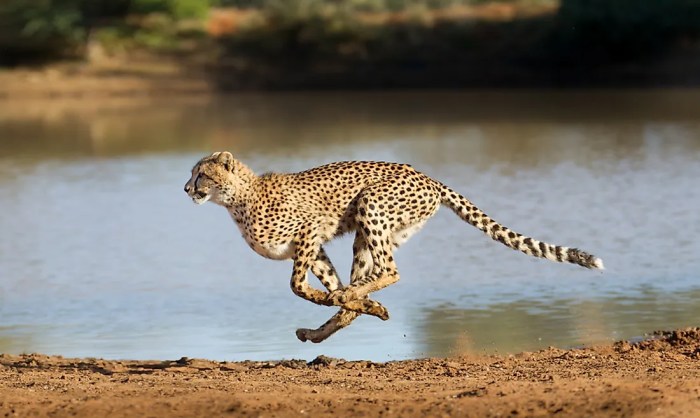A cheetah can run at approximately 100 km/hr – The cheetah, renowned for its unparalleled speed, can reach astonishing speeds of approximately 100 km/hr, making it the fastest land animal. This remarkable ability has shaped the cheetah’s hunting strategies, survival instincts, and evolutionary trajectory. Delving into the cheetah’s extraordinary speed, we explore the physical adaptations, aerodynamic principles, and hunting techniques that enable this magnificent creature to outrun its prey.
The cheetah’s slender and aerodynamic body, coupled with its long, muscular legs, provides the foundation for its exceptional speed. Its unique stride, characterized by an extended stride length and high stride frequency, further enhances its velocity. Additionally, the cheetah’s flexible spine allows for greater extension during each stride, maximizing its reach and speed.
1. Introduction
The cheetah’s extraordinary speed, reaching approximately 100 km/hr, is a crucial adaptation that plays a significant role in its survival. This remarkable ability enables the cheetah to outpace its prey, securing its position as an apex predator. Additionally, the cheetah’s unique physical adaptations, including its streamlined body and specialized limbs, contribute to its unmatched velocity.
2. Factors Influencing Speed

The cheetah’s speed is a result of a combination of factors. Aerodynamics and body structure play a crucial role in reducing drag and enhancing efficiency. The cheetah’s sleek body and retractable claws minimize air resistance, while its long tail acts as a rudder, providing stability during high-speed chases.
Moreover, the cheetah’s long stride length and high stride frequency further contribute to its exceptional velocity.
3. Comparison to Other Animals

While the cheetah is renowned for its speed, it is not the only fast-running animal. Lions, zebras, and horses also exhibit impressive speeds. However, the cheetah’s specialized adaptation for speed gives it a distinct advantage in short-distance sprints. Its ability to reach 100 km/hr within a few seconds surpasses that of other animals, making it the fastest land mammal.
4. Hunting Strategies

The cheetah’s speed is vital for its hunting success. It relies on its explosive acceleration to pursue and capture prey. The cheetah’s hunting strategy involves stalking its target, then launching a short, high-speed chase. Its ability to outpace its prey allows it to secure kills efficiently, primarily targeting gazelles and impalas.
5. Conservation and Threats
The cheetah faces numerous threats, including habitat loss, fragmentation, and poaching. Conservation efforts are crucial to protect this iconic species. Establishing and managing protected areas, reducing human-wildlife conflict, and implementing anti-poaching measures are essential steps to ensure the cheetah’s survival.
Essential FAQs: A Cheetah Can Run At Approximately 100 Km/hr
What is the top speed a cheetah can reach?
Cheetahs can reach speeds of approximately 100 km/hr (62 mph).
How does the cheetah’s body structure contribute to its speed?
The cheetah’s slender and aerodynamic body, long legs, and flexible spine allow for efficient and rapid movement.
How does the cheetah’s stride differ from other animals?
Cheetahs have an extended stride length and high stride frequency, which contribute to their exceptional speed.
What hunting techniques does the cheetah employ?
Cheetahs use their speed to pursue and capture prey, often using a combination of sprinting and short bursts of acceleration.
What are the conservation threats facing cheetahs?
Cheetahs face threats such as habitat loss, poaching, and human-wildlife conflict, which impact their survival and population stability.